- Top Employee Onboarding Software
- Why Use Employee Onboarding Software?
- Key Features of Effective Onboarding Software
- How To Choose The Right Onboarding Software?
- Which is the Best Onboarding Software?
- Frequently Asked Questions (FAQs)
- What Is Upskill And Reskill?
- Difference Between Reskilling And Upskilling
- Upskilling for Workplace Advancement
- Reskilling for Career Transformation
- Crafting Successful Upskill and Reskill Strategies
- Upskill And Reskill Strategizing: Things to Keep in Mind
- Measuring the Impact of Skill Development Initiatives
- Frequently Asked Questions
- What’s a Skill Gap?
- Employee Skill Gap Analysis: Why Do We Need It?
- How To Conduct Employee Skill Gap Analysis?
- Addressing Skill Gaps Through Training and Hiring
- Utilizing Skills Gap Analysis for Strategic Planning
- Leveraging Employee Skill Gap Analysis: Things To Keep In Mind
- Frequently Asked Questions
- Transformative Role of AI in Talent Acquisition
- Impact of AI on Business Recruiting
- Overcoming Challenges in AI-Driven Talent Acquisition
- Starting with AI in Talent Acquisition
- Future Landscape of AI in Talent Acquisition
- Frequently Asked Questions
- HR In The Hot Seat - Challenges With Evolving Workforce
- Mastering Effective HR Management: Tips For Overcoming Challenges
- Summing Up
- The Future of HR: Key Trends for 2024
- Skill-Based Hiring
- Prioritizing Employee Experience, Engagement & Well-being
- AI-Empowered Workforce Evolution and Its Impact
- Taking Diversity, Equity, and Inclusion Beyond Mandates
- Hybrid and Remote Work
- Embracing the Gig Economy and Blended Workforce
- Transparent HR Practices
- Climate Change Adaptation in HR Practices
- Leveraging HR Analytics for Data-Driven Decisions
- Continuous Learning & Development to Improve Productivity
- The Office Buzz in 2024
- Bottom Line - HR Operating Model Needs A Shift
- Importance and Impact of Recognizing Employee Birthdays
- Professional Birthday Wishes for Employees (All Experience Levels)
- Personalized Birthday Wishes for Employees in Different Roles
- Fun Birthday Wishes for Employees (with Templates)
- Birthday Wishes for Remote Employees
- Heartfelt Birthday Wishes for Employees
- Belated Birthday Wishes for Employees
- Simple & Sweet Birthday Wishes for Employees
- Celebrating Employee Birthdays: Ideas and Traditions
- Tips and Ideas for Sending Birthday Wishes to Employees
- Closing Thoughts
- Frequently Asked Questions
- What Is An Employee Referral?
- Benefits of Implementing Employee Referral Programs
- Setting Up an Effective Employee Referral Program
- Employee Referral Email
- Employee Referral Scheme
- Overcoming Challenges of Employee Referrals
- Companies with Best Employee Referral Programs
- Employee Referral Programs: Best Practices
- Closing Thoughts
- Frequently Asked Questions (FAQs)
- Importance of Team Building Activities
- Types of Team Building Activities
- Outdoor Team Building Activities for Employees
- Indoor Team Building Activities for Employees
- Easy Team Building Activities for Remote Employees
- Team Building Activities For New Employees (Icebreakers)
- Fun Team Building Activities for Different Goals
- To Boost Communication and Collaboration
- To Reduce Stress Levels and Promote Well-being
- Aligning Team Purpose and Values with Strategic Activities
- Final Remarks
- Frequently Asked Questions
- Importance of Employee Appreciation Quotes
- Work Appreciation Quotes for Employees
- Employee Appreciation Quotes for Hard Work Recognition
- Employee Appreciation Quotes for Teamwork and Collaboration
- Appreciation Quotes for Celebrating Employee Anniversaries and Milestones
- Employee Appreciation Quotes for Strong Work Ethics
- Employee Appreciation Quotes for Project & Goal Completion
- Employee Appreciation Quotes for Quality of Work
- Employee Appreciation Quotes for Creativity and Innovation
- Appreciation Quotes for Managers
- Peer-to-Peer Employee Appreciation Quotes
- Appreciation Quotes for Employees Leaving the Company
- Employee Appreciation Quotes for Thoughtful Gestures
- Funny Employee Appreciation Quotes
- Short Employee Appreciation Quotes
- Employee Appreciation Quotes for Different Roles
- Employee Appreciation Quotes for Senior Leadership
- Creative Ways to Use Employee Appreciation Quotes
- Summary
- Frequently Asked Questions (FAQs)
- What is Employee Satisfaction?
- Importance of Employee Satisfaction
- Objectives of Employee Satisfaction
- Employee Satisfaction vs. Employee Engagement
- Key Reasons for Employee Dissatisfaction
- Strategies for Improving Employee Satisfaction
- Ways to Measure Employee Satisfaction
- Best Practices for High Employee Satisfaction
- Final Remarks
- Frequently Asked Questions (FAQs)
- How to Craft Effective Employee Appraisal Comments
- Key Areas to Focus in Performance Review
- Comments On Hard Work & Dedication
- Assessing Interpersonal Skills
- Evaluating the Ability to Collaborate & Work in Teams
- Gauging Punctuality
- Commenting on Communication Style
- Reviewing Time Management and Productivity
- Leadership in Performance Appraisals
- Assessing Creativity & Innovation
- Evaluating Problem-Solving Abilities
- Recognizing Flexibility and Dependability in Reviews
- Employee Appraisal Comments for Different Roles
- Summary
- Frequently Asked Questions (FAQs)
- Employee Grievance Meaning
- Importance of Employee Grievance Process
- Types of Workplace Grievances
- Reasons for Employee Grievances
- Employee Grievance Procedure
- Steps in the Employee Grievance Handling Process
- Employee Grievance Form Example
- Final Remarks
- Frequently Asked Questions (FAQs)
- What is Company Culture?
- Importance of Company Culture
- Types of Company Culture
- Factors Contributing to Organizational Culture
- Assessing & Developing Corporate Culture
- Company Culture - It’s not just Perks or Feels
- Good Company Culture Examples
- Developing Company Culture: Best Practices
- Closing Thoughts
- Frequently Asked Questions (FAQs)
- What is Employee Empowerment?
- Benefits of Empowering Employees
- Employee Empowerment vs. Micromanagement
- Strategies for Effective Employee Empowerment
- Role of Managers in Fostering Empowerment
- Organizational Structure Supporting Empowerment
- Overcoming Barriers to Employee Empowerment
- Frequently Asked Questions (FAQs)
- What is Employer Branding?
- Importance of Employer Branding Strategy
- How to Build an Employer Branding Strategy?
- Strategies for Building a Strong Employer Brand
- How to Measure and Boost Your Employer Branding Success?
- Examples of Strong Employer Brand Strategy
- Best Practices for an Effective Employer Branding Strategy
- Closing Thoughts
- Frequently Asked Questions (FAQs)
- What are Employee Wellness Programs?
- Importance of Employee Wellness Programs
- Examples of Employee Wellness Programs
- Real-Life Examples of Corporate Wellness Programs
- Strategies for Encouraging Participation
- Supporting Diverse Employee Needs
- Creating Comprehensive Wellness Programs
- Measuring the Impact on Business and Employees
- Closing Thoughts
- Frequently Asked Questions (FAQs)
- What is Talent Management?
- Developing a Winning Talent Management Strategy
- Models and Frameworks
- Tips for Framing Effective Talent Management Strategy
- Looking Ahead: Recent Trends in Talent Management
- Frequently Asked Questions
- Role of AI in HR: Addressing Common Challenges
- Artificial Intelligence in HR Processes
- AI Tools for HR Functions
- How to Adopt AI in HR?
- Addressing Challenges of AI in HR
- Ethical and Responsible AI Use
- The Future of AI in HR
- Closing Thoughts
- Frequently Asked Questions
- What is Performance Management?
- Elements of Effective Performance Management
- Performance Management Cycle
- Differentiating Performance Management
- Benefits of Performance Management With Examples
- Challenges faced in Performance Management and their Solutions
- Future Trends in Performance Management
- Frequently Asked Questions
- Changing Role of HRM
- Changing Role Of HR Manager
- Technology and the Changing Role of HRM
- The Rise of AI and Machine Learning in HR
- Mobile Technology's Impact on HR Practices
- The Significance of People Analytics in HR
- Navigating the Future of HR Technology
- Final Remarks
- Frequently Asked Questions
- Compensation Management Meaning
- Compensation Types
- Breaking Down The Compensation Management Process
- HR Software for Compensation Management
- Current Trends in Compensation Management
- Frequently Asked Questions
- Defining Flexible Work Arrangements
- Flexible Working: Advantages for Businesses
- Challenges of Flexible Work Arrangements
- Crafting Flexible Working Practices
- Types Of Flexible Work Arrangements
- Comparing Flexible Work Arrangements
- Real-Life Examples of Flexible Work Arrangements
- Final Remarks
- Frequently Asked Questions
- Conflict Resolution Meaning
- Conflict Origins
- Tried & Tested Conflict Resolution Strategies
- Methods of Conflict Management at Workplaces
- Conflict Resolution Strategies: Top Management Tips
- Summary
- Frequently Asked Questions
- Career Development Meaning
- Career Development Plan for Employees
- Career Development in HRM: Growth Ideas For Employees
- Issues in Career Development and Their Solutions
- Closing Thoughts
- Frequently Asked Questions
- Understanding Compensation
- Exploring Benefits
- Difference between Compensation and Benefits
- Compensation & Benefits Structure
- Final Remarks
- Frequently Asked Questions
- Defining Recruitment in HR Practices
- Exploring Talent Acquisition in HR
- Understanding Talent Acquisition vs Recruitment
- When to Recruit or Acquire Talent
- Talent Acquisition vs Recruitment: Responsibilities
- From Recruitment To Talent Acquisition
- Closing Thoughts
- Frequently Asked Questions
- Work Culture Meaning
- Types of Work Cultures
- Components of Culture
- Best Work Culture Examples Set By Top Companies
- Creating a Positive Work Culture
- Closing Thoughts
- Frequently Asked Questions
- Defining Learning vs Development
- Importance of Learning and Development
- L&D Activities for Employees
- Choosing the Right L&D Activities
- Crafting an Effective L&D Strategies
- Aligning L&D Strategy with Business Goals
- Designing Engaging Learning Journeys
- Learning and Development Process: KPIs
- ROI in Learning and Development
- Emerging Trends in L&D
- Closing Thoughts
- Frequently Asked Questions
- What Is Leadership Development?
- Key Skills for Leaders
- How To Develop Leadership Skills in Organizations?
- What Is A Leadership Development Program?
- How To Develop A Leadership Development Program?
- Example of A Leadership Development Plan
- Benefits of Leadership Development Training
- Frequently Asked Questions
- Defining Diversity Training
- Importance of Diversity Training
- What are the Types of Diversity?
- Types of Diversity Training Methods
- Diversity Training Activities
- Choosing A Diversity Training Program
- How to Implement Diversity Initiatives
- Best Diversity Training Programs (Real-Life Examples)
- Improving the Effectiveness of Diversity Training
- Tracking and Evaluating the Results of DE&I Training Efforts
- Essential Elements for Successful Diversity Training
- Closing Thoughts
- Frequently Asked Questions
- Defining Occupational Health & Safety
- Evolution of Workplace Health and Safety
- Identifying Common Workplace Hazards
- Global Impact on Occupational Health & Safety
- Managing Employee Health and Safety Risks
- Occupational Health and Safety Problems
- Future of Occupational Health and Safety
- Frequently Asked Questions
- Employee Orientation Defined
- Employee Onboarding Explained
- Orientation and Onboarding: Understanding the Difference
- Importance of Orientation and Onboarding
- Crafting Comprehensive Integration Strategies
- Quick Tips for Orientation and Onboarding
- Frequently Asked Questions
- What is HR Metrics?
- Importance of HR Metrics
- HR Metrics Examples in Recruitment
- HR Metrics Examples in Employee Retention
- HR Metrics Examples in Revenue
- Other Common HR Metrics
- Soft HR Metrics Example
- HR Metrics Formula
- Utilizing HR Metrics Effectively
- Future of HR Metrics
- Summary
- Frequently Asked Questions
- Defining Decision Making Process
- Key Concepts In Decision Making
- Decision Making & Problem Solving
- Tips For Improving Decision Making Skills
- Selected Practice Questions & Answers
- Conclusion
- Frequently Asked Questions (FAQs)
- A case(s) of miscommunication
- The devil is in the (resume) details
- One for the complaints!
- What is an Exit Interview?
- Benefits of Exit Interviews to an Organization
- How to Conduct Exit Interviews?
- Exit Interview: Sample Questions to Ask
- Overcoming Challenges of Exit Interviews
- Exit Interviews: Best Practices
- Closing Thoughts
- Frequently Asked Questions
- Technology in the Workplace
- Benefits of Tech Integration
- Technology in the Workplace: Key Functions
- How Technology Normalized Remote Work
- Workplace Technology: Top Tools and Software
- Steps for Effective Technology Implementation
- Overcoming Tech Implementation Challenges
- Ethical Considerations in Tech Use
- Keeping Pace with Tech Trends
- Closing Thoughts
- Frequently Asked Questions
- What is Ethical Leadership?
- Principles of Ethical Leadership
- Difference between Ethics and Integrity
- Importance of Ethical Leadership
- Ethical Leadership in Practice
- Overcoming Challenges
- Frequently Asked Questions
- Embracing Change Management
- Mastering People Analytics
- Enhancing Stakeholder Relationships
- Navigating Diversity, Equity & Inclusion
- Upholding Ethics and Data Privacy
- Developing Critical Thinking
- Advancing Negotiation Techniques
- Fostering Inter-departmental Collaboration
- Building Resilience in HR
- Frequently Asked Questions
- What is Mental Health?
- Benefits of a Mentally Healthy Workforce
- Prioritising Mental Health: Creating a Culture of Support
- Final Remarks
- Frequently Asked Questions
- Gen Z vs Millennials - What is the difference?
- Retain and Engage Gen Z Employees: Need and Strategies
- Strategies to Retain and Engage Gen Z Employees
- Rethinking Requirements
- Final Remarks
- Frequently Asked Questions
- Understanding Millennial Leadership Needs
- Key Leadership Skills for Millennials
- How To Develop Millennial Into Leaders
- Additional Strategies to Develop Leaders
- Learning Preferences of Millennials
- Benefits of Investing in Millennial Leaders
- Closing Thoughts
- Frequently Asked Questions
- Understanding Fluff
- Examples of Interview Fluff
- Identifying Interview Fluff
- Addressing Interview Fluff
- Seeing Through the Fluff
- Frequently Asked Questions
- What is the Gender Pay Gap?
- Is the Gender Pay Gap Real?
- Factors Affecting the Gender Pay Gap
- How Age Impacts Women’s Earnings
- The ‘Motherhood Penalty’
- Education's Role in Wage Differences
- Racial and Ethnic Disparities in Pay
- Closing the Gender Gap
- Frequently Asked Questions
- Top Weirdest Late-To-The-Office Excuses
- The Fine Art of Balancing Wit and Wisdom in HR
- Understanding Social Media Recruiting
- Crafting Your Social Media Recruitment Strategy
- Implementing Your Strategy Effectively
- Popular Platforms for Recruitment
- Navigating the Downsides of Social Media Recruiting
- Measuring Success and Adjusting Strategy
- Summary
- Frequently Asked Questions
- Who Is A High Potential (HIPO) Employee?
- Characteristics of A High Potential (HIPO) Employee
- High Potential Employee Identification
- Grooming High Potential Employees
- Why High Potential Employees Leave
- How Do You Retain High Potential Employees?
- High Potential Employee Development: Best Practices
- Closing Thoughts
- Frequently Asked Questions
- What is Digital Fluency?
- Why Digital Fluency Matters?
- Difference between Digital Literacy and Digital Fluency
- Key Components of Digital Fluency
- Achieving Digital Fluency
- Overcoming Challenges
- Future of Workforce Digital Fluency
- Frequently Asked Questions
- What is Loud Quitting?
- Pros and Cons of Loud Quitting
- Reasons Behind the Trend
- Analyzing the Impact
- How HR Can Navigate the Loud Quitting Uproar
- Preventive Strategies
- Closing Thoughts
- Frequently Asked Questions
- Defining Emotional Intelligence in HR
- Why Emotional Intelligence Matters for HR Leaders
- How To Build Emotional Intelligence in HR
- Integrating EQ into HR Practices
- Impact of EQ on Company Culture
- Emotional Intelligence in HR: Major Challenges
- Final Remarks
- Frequently Asked Questions
- Understanding Internal Job Posting
- Internal Job Posting: Pros and Cons
- The Internal Job Posting Process
- Writing Effective Ads for Internal Job Posting
- Strategies for Success of Internal Job Posting
- Summary
- Frequently Asked Questions
- Understanding Workplace Bias
- Common Types of Bias in HR
- Closing Thoughts
- Frequently Asked Questions
- What is a Dry Promotion?
- Dry Promotion: Pros and Cons for Companies
- Impact of Dry Promotion on Employee Retention
- Preventing Talent Loss After Dry Promotions
- Closing Thoughts
- Frequently Asked Questions
- What Is A Stay Interview?
- Importance Of Stay Interviews
- Benefits And Challenges Of Stay Interviews
- Planning And Conducting Stay Interviews
- Stay Interviews: 20 Sample Questions To Ask
- Best Practices For Effective Stay Interviews
- Summary
- Frequently Asked Questions
- Who Is A Boomerang Employee?
- Reasons For Returning
- Benefits Of Hiring Boomerang Employees
- Challenges Of Rehiring
- Interviewing Boomerang Candidates: Sample Questions
- Enhancing The Hiring Process
- Making Informed Decisions
- Final Remarks
- Frequently Asked Questions
- Talent Pipeline Meaning
- Significance of Talent Pipelines
- Advantages of a Talent Pipeline
- Building a Talent Pipeline
- Maintaining a Talent Pipeline
- Attracting Top Talent
- Implementing the Strategy
- Frequently Asked Questions
- What is Micromanagement?
- Recognizing Micromanagement
- Leadership versus Micromanagement
- Keeping Micromanagement in Check
- Beyond Micromanagement
- Summing Up
- Frequently Asked Questions
- Recognizing Signs Of A Bad Hire
- Understanding The Impact On Teams
- Dealing With A Bad Hire
- Preventing Future Bad Hires
- Closing Thoughts
- Frequently Asked Questions
- Defining Neurodiversity
- Importance of Neurodiversity in the Workplace
- Moving Towards Inclusive Environments
- Final Remarks
- Frequently Asked Questions
- Understanding the Generation Gap
- Multigenerational Workforce: Debunking Stereotypes
- Strategies for Bridging the Gap
- Benefits of a Multigenerational Workforce
- Final Remarks
- Frequently Asked Questions
- Defining Productivity Theatre: All Show, No Go
- 5 Key Drivers of Fake Productivity
- Solutions to Combat Productivity Theatre
- Summary
- Frequently Asked Questions
- Defining Grumpy Staying
- Why do Grumpy Stayers not Leave?
- Recognizing the Signs
- Exploring the Causes
- Understanding the Impact
- Addressing the Issue
- Taking Action: Addressing Grumpiness with Empathy
- After the Conversation
- When Grumpy Staying Continues
- Closing Thoughts
- Frequently Asked Questions
- The Rationale Behind Office Peacocking
- Impact on Company Culture
- Impact on Employees
- Case Studies: Examples of Office Peacocking
- The Downside: Potential Pitfalls of Office Peacocking
- Practical Tips for Implementing Office Peacocking
- Frequently Asked Questions
- 13 Common Mistakes Young Managers Make
- Strategies To Avoid Mistakes (Individual Growth)
- How Young Managers Can Boost Teamwork
- Learning From Errors
- Summary
- Frequently Asked Questions
- Understanding Great Regret - What causes the shift shock?
- Impact of Great Regret
- How can HR help make the situation better?
- Closing Thoughts
- Frequently Asked Questions
- Understanding the HR Budget
- Key Components of an HR Budget
- Preparing an HR Budget Step-by-Step
- Importance of HR Budgeting in Management
- Final Remarks
- Frequently Asked Questions
- What are Pre-Employment Assessments?
- Importance of Pre-Employment Testing
- Types of Pre-Employment Assessments
- 15 Tips for Creating Effective Pre-Employment Assessments
- Closing Thoughts
- Frequently Asked Questions
- Exploring the Productivity Paradox
- Understanding the Impact of Solow Paradox
- Productivity Paradox: Why it Matters for Recruiters & HRs
- Identifying Causes and Challenges
- Strategies for Enhancing Productivity
- AI & the Modern-Day Productivity Paradox
- Beyond Technology: Building a Productive Workforce
- Summary
- Frequently Asked Questions
- Understanding the Great Reshuffle 2.0
- Preparing Leaders for the Change
- HR’s Role in Handling Great Reshuffling 2.0
- The Way Ahead
- Frequently Asked Questions
- Definition Of Managerial Grid
- Managerial Grid Theory Explained
- Application Of Managerial Grid
- Criticisms And Limitations
- Evolution And Contemporary Perspectives
- Integrating Managerial Grid With Other Models
- Practical Steps For Implementing Managerial Grid
- Conclusion
- Frequently Asked Questions
- Understanding Skills Taxonomy
- Why do we Need Skills Taxonomy?
- Benefits of Skills Taxonomy
- Components of Skills Taxonomy
- Building a Skills Taxonomy: A Step-by-Step Guide
- Skill Taxonomies vs Intelligence Tools
- Closing Thoughts
- Frequently Asked Questions
- Definition Of Team Building
- Stages Of Team Development
- Top 10 Strategies For Effective Team Building
- Team Building Activities
- Best Practices For Effective Team Building
- Setting Team Building Objectives
- Challenges In Team Building
- Conclusion
- Frequently Asked Questions (FAQs)
- Defining Job Shadowing
- Unpacking the Benefits
- Setting Up the Experience
- Job Shadowing vs Internship
- Dos and Don'ts for HR Professionals
- Closing Thoughts
- Frequently Asked Questions
- Employee Journey Mapping: Meaning & Importance
- Stages of the Employee Journey
- Steps for Effective Mapping
- Employee Journey Map: Where does it begin?
- Employee Journey Map: Template
- Best Practices & Tips
- Summary
- Frequently Asked Questions
- Why are Performance Appraisals needed?
- Evolution of Performance Management
- Modern Performance Practices
- Benefits of Modern Performance Appraisals
- The Future
- Frequently Asked Questions
- Is Experience the Sole Indicator of Success?
- Why Hire Inexperienced Talent?: Key Advantages
- Skills to Look For in Inexperienced Talent
- Challenges and Considerations in Hiring Inexperienced Talent
- Final Remarks
- Frequently Asked Questions
- What is a Company Retreat?
- Company Retreat Ideas: Team-Building & Exploration
- Relaxation and Celebration
- Planning Your Retreat: Things to Keep in Mind
- Closing Thoughts
- Frequently Asked Questions
- Understanding HR Forecasting
- HR Forecasting Key Concepts
- Steps for Implementing HR Forecasting
- Common HR Forecasting Methods
- Closing Thoughts
- Frequently Asked Questions
- What is ESG?
- HR and ESG - Why Care?
- ESG in HR Strategy
- Challenges for HR
- Future of ESG in HR
- Frequently Asked Questions
- Defining the Great Betrayal
- Reasons for Its Spread
- Impact on Workers
- Impact on Corporations
- Rebuilding Trust & Valuing Employees
- Closing Thoughts
- Frequently Asked Questions
- Importance of Clear Expectations
- Setting Expectations Early
- Communicating Expectations Effectively
- Differentiating Expectations
- Reviewing and Adjusting Expectations
- Summing Up
- Frequently Asked Questions
- Understanding KRA Frameworks And Models
- KRAs vs KPAs and KPIs
- Monitoring and Tracking KRAs
- KRAs in Various Roles
- Impact of KRA Frameworks and Models on Organizational Success
- Frequently Asked Questions
- Where: The Place of Work
- When: The Time of Work
- How Much Work: Alternate Employment Models
- Who Does the Work: Intelligence
- Designing Organizations with the Four Dimensions of Work
- Summing Up
- Simplifying Processes: The Foundation of Efficiency
- Reducing Unnecessary Meetings: Reclaiming Valuable Time
- Building Strong Accountabilities: Ensuring Responsibility
- Role of HR in Addressing Inefficiencies
- Continuous Improvement: A Commitment to Excellence
- Leadership's Role in Driving Efficiency
- Conclusion: A Holistic Approach to Efficiency
- Understanding Financial Freedom
- Benefits of Empowering Employees Financially
- Empowering Employees Through Financial Literacy
- Financial Topics That Need Attention Based On Career Stage
- Summing Up
- Frequently Asked Questions
- Defining Employee Voice
- Benefits of Amplifying Employee Voice
- Strategies and Tools
- Encouraging Participation
- Closing Thoughts
- Frequently Asked Questions
- Appraisal Blues: Signs of Unhappy Employees
- Addressing Unhappiness Post-Appraisal
- Non-Monetary Solutions for Dissatisfied Employees
- Summing Up
- Frequently Asked Questions
- Women in the Middle Eastern Workforce
- Importance of DEIB
- Role of HR in Building Inclusive Workplaces for Women
- Measuring Inclusion Progress: Key Metrics
- Closing Thoughts
- Frequently Asked Questions
- Preparing for the Conversation
- Conducting the Conversation
- Best Practices for the Talk
- After the Conversation
- Helping Employees Grow
- Frequently Asked Questions
- Understanding HR Exhaustion
- Factors Leading To HR burnout
- Impact Of HR Burnout
- Strategies To Prevent And Manage HR Burnout
- Role Of Technology In Preventing Burnout
- Celebrating HR Successes
- Summary
- Frequently Asked Questions
- Common Mistakes When Hiring Young Talent
- Building Connections with Candidates
- Summary
- Frequently Asked Questions
- Walking a mile in the employee’s shoes
- Conducting Humane Layoffs
- Remote Layoffs Management
- Supporting Laid-off Workers
- Managing the Aftermath
- Wrapping Up
- Frequently Asked Questions
- Importance of Shortening Time-to-Hire
- Shortening Hiring Time: Pre-Application Stage
- Reducing Hiring Time: Application Stage
- Hacks to Shorten Hiring Time: Interview Stage
- Reducing Hiring Time: Offer Stage
- 5 Other Important Hacks & Strategies
- Final Remarks
- Frequently Asked Questions
Employee Referral 101: Unlock Benefits, Best Practices & Top Schemes
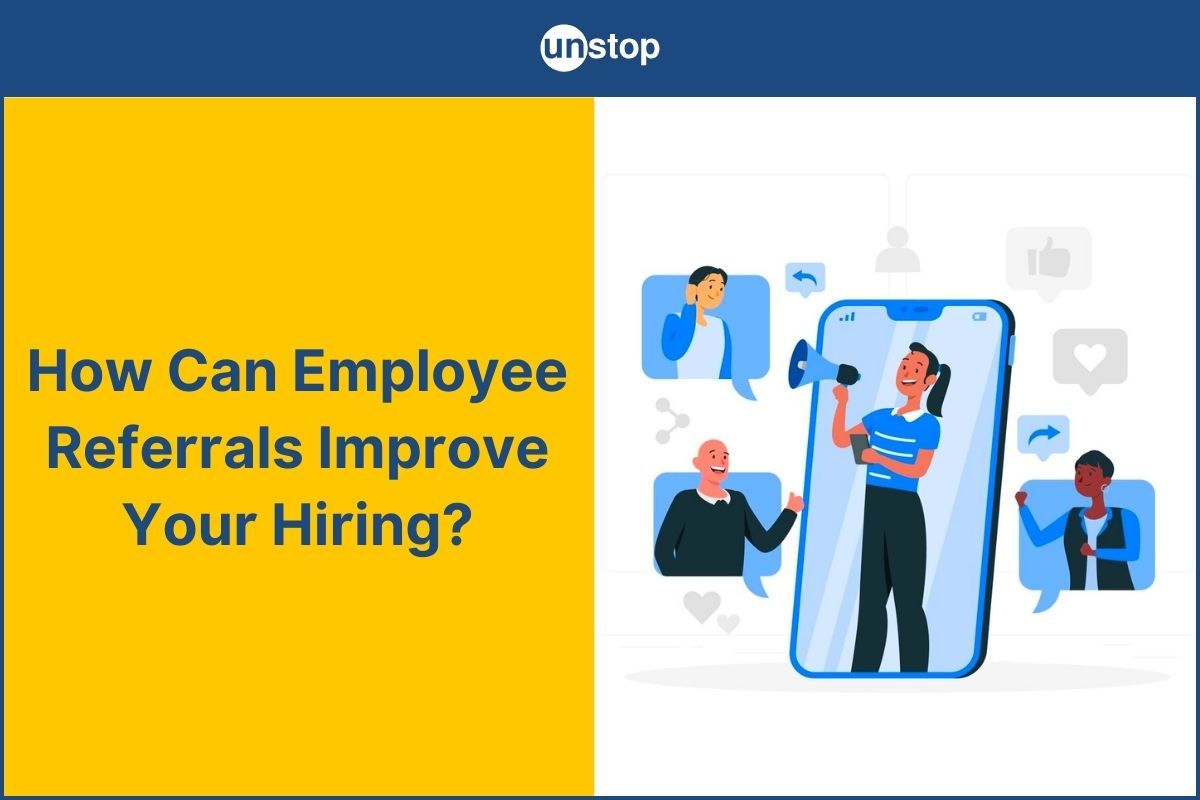
Hiring is never an easy job. Finding the right fit for a role can be time-consuming and resource-intensive. But what if there was a way to ease the process? Like employee referrals!
Employee referral offers a win-win situation for both, the company and the referred candidate. Leveraging existing talent to bring in new skilled individuals enhances team cohesion and employee retention rates. Moreover, employee referral programs are proven to yield high-quality candidates who align with company culture and values, fostering a positive work environment.
This blog delves into the intricacies of employee referral systems, highlighting their impact on recruitment success and organizational growth. Let's dive in.
What Is An Employee Referral?
Definition: An employee referral is when a current employee of a company recommends a candidate for a job opening within the organization. This recommendation is based on the employee's knowledge of the candidate's skills, experience, and fit for the role.
Employee referrals are a common recruitment strategy companies use to attract top talent and often result in successful hires due to the pre-existing relationship between the referring employee and the candidate.
Benefits of Implementing Employee Referral Programs
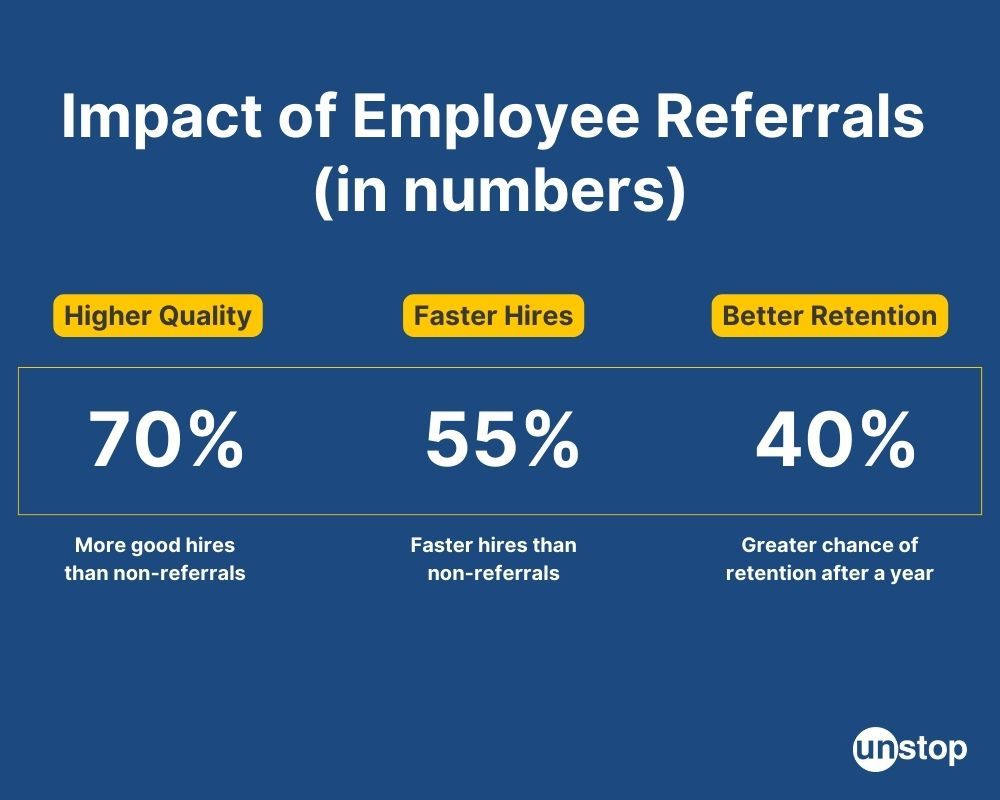
High-Quality Candidates
Employee referral programs help companies tap into a pool of top talent. Current employees recommend individuals they know, trust, and believe will excel in the organization. This method often leads to hiring high-quality candidates who are more likely to succeed within the company.
Did you know? Harvard Business Review reported that “for every 100 applicants, referrals generated 70% more good hires than non-referrals.”
Time-to-Hire Reduction
Employee referrals streamline the recruitment process by presenting pre-screened candidates directly to hiring managers. This saves time that would have been spent sifting through numerous applications from various sources. This improves the speed at which positions are filled, significantly reducing the time-to-hire.
It’s a fact! As per ET HRWorld, employee referrals are hired 55% faster than through job boards. That’s a quick turnaround time!
Enhanced Company Reputation
Employee referrals can significantly boost an employer’s brand by showcasing it as a sought-after place to work. When current employees refer their friends or acquaintances, it signals contentment with the company culture and working environment. This satisfaction translates into positive endorsements that attract potential candidates seeking workplaces where employees are happy and engaged.
Lower Turnover
Referrals tend to have higher retention rates and lower turnover compared to other sources of hires. When employees recommend someone for a position, they often consider cultural fit and job compatibility, resulting in longer-lasting employment relationships. This benefits the company by reducing recruitment costs associated with frequent turnovers.
It’s a fact! Reports suggest that compared to non-referral hires, there is a 40% greater likelihood of referred hires being retained after one year.
Cost Savings
Employee referral programs can lead to cost savings in recruitment advertising and external agency fees. By utilizing internal resources for talent acquisition, companies can minimize expenses related to posting job listings on various platforms or hiring external agencies for candidate sourcing. This cost-effective approach is advantageous for businesses aiming to optimize their recruitment budget.
Improved Understanding of Expectations
Referred candidates typically possess a better grasp of what is required in their roles because they have insights from their referring colleagues. This understanding results in quicker adaptation to their new positions, leading to increased employee retention rates. By being aware of both explicit requirements and implicit expectations, referred employees are more likely to succeed in their roles.
Did you know? Statistics on employee referrals show that for 70% of employers, referred hires proved to be a better fit with the company culture and values than non-referred hires.
Setting Up an Effective Employee Referral Program

Define Eligibility Criteria
To ensure fairness, clearly define criteria for eligible referrals. This transparency helps employees understand who they can refer. Employees should know the qualifications needed to refer a candidate successfully. For example, specific job requirements or experience levels.
Streamline Submission Process
Develop a straightforward process for submitting referrals. An online portal or dedicated email address makes it easy for employees to recommend candidates. With a streamlined system in place, more employees are likely to participate in the program. This can lead to increased referral submissions and potential new hires.
Add Incentives
To maximize the effectiveness of an employee referral program, companies should actively encourage their staff to participate. Offering incentives, such as monetary rewards or extra vacation days for successful referrals, can motivate employees to recommend qualified individuals.
Employee Referral Email
One of the most common and effective ways to introduce the employee referral program is by sending an email about it. It helps inform the employees about the details of the program, while also encouraging participation.
However, the email must be informative and helpful - easing the process for the employees. Remember, it should not feel like an added responsibility, but an exciting opportunity.
Structure of Employee Referral Email
The basic structure of an employee referral email sent by the hiring department typically includes the following components:
- Introduction: The email should start with a warm greeting and a brief introduction explaining the purpose of the email.
- Job Opening Details: Provide information about the job opening, including the position title, department, location, and any key responsibilities or qualifications.
- Employee Referral Program: Outline the benefits of the employee referral program, such as referral bonuses or rewards for successful hires.
- How to Refer: Clearly explain the process for making a referral, including any specific steps or forms that need to be completed.
- Encouragement: Encourage employees to refer qualified candidates and emphasize the importance of their recommendations in the hiring process.
- Contact Information: Provide contact information for the hiring department or HR team in case employees have any questions or need further assistance.
- Call to Action: End the email with a clear call to action, such as encouraging employees to start referring candidates or inviting them to attend a recruitment event.
By following this structure, the hiring department can effectively communicate the employee referral program to all employees and encourage them to participate in the recruitment process.
Employee Referral Email Sample
Subject: Introducing Our Employee Referral Program
Dear Team,
We're thrilled to announce the launch of our brand-new Employee Referral Program! We're currently seeking talented individuals to join our growing team in two key roles:
- Influencer Marketing Executive: This savvy strategist will develop and execute data-driven influencer campaigns, building meaningful partnerships that amplify our brand voice and reach new audiences.
- Head of Design: This visionary leader will shape the visual identity of our company, driving creative excellence and innovation across all marketing materials and platforms.
- We believe that great talent knows great talent, which is why we are turning to you, our valued employees, to help us find the perfect candidates for these positions.
Here's how it works:
- Spread the word: Share the job descriptions with your network – friends, family, former colleagues, anyone you think would be a great fit.
- Submit your referral: Once you've connected a candidate, submit their information through our easy-to-use referral portal.
- Get rewarded: If you refer a candidate who gets hired for one of these roles, you will be eligible for a cash bonus as a token of our appreciation for helping us grow our team with top-notch talent.
Why refer?
- Help the team grow: Attract top talent and contribute to our success.
- Make a difference: Connect someone with a fulfilling career opportunity.
- Get rewarded: Earn a generous bonus for your successful referral.
Ready to share the love? Visit our Employee Referral Program portal at [Portal Link] to learn more and submit your referrals today!
Please refer to the attached document for more details on the positions and how the referral bonus works. If you have any questions or would like to refer someone, please reach out to our HR team.
Thank you for your continued dedication to our company. We look forward to working together to build an even stronger team.
Best regards,
The HR Team
Remember to personalize the email further by mentioning specific skills or qualities that are particularly valuable for the open roles. Also, highlight the unique benefits and culture of your company to attract potential candidates. And make sure the referral process is clear and easy to follow.
Employee Referral Scheme
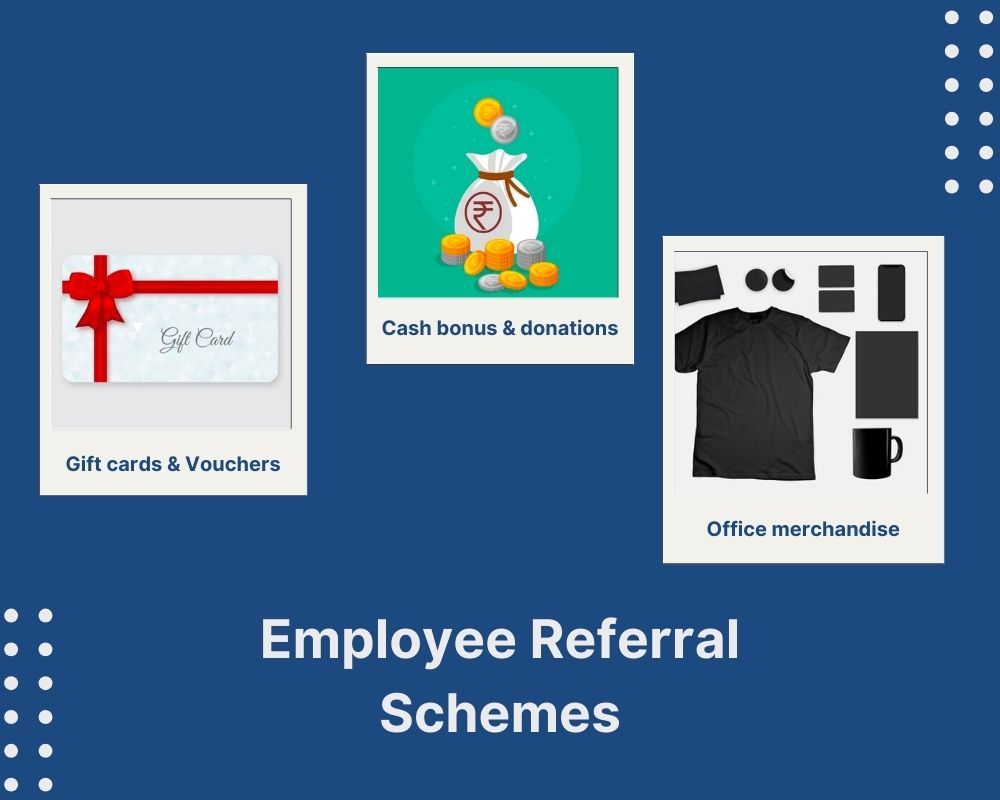
Here are some examples of employee referral schemes, categorized by reward type:
Cash Bonuses:
- Standard bonus: Offer a fixed amount of cash for every successful referral.
- Tiered bonus: Increase the bonus amount based on the position filled or the candidate's performance during the first year.
Other Incentives:
- Gift cards & Experiences: Give employees gift cards to popular retailers or restaurants. Or provide access to experiences like concert tickets, weekend getaways, or sporting event tickets.
- Company swag: Offer branded merchandise like apparel, tech accessories, or travel mugs.
- Paid time off: Reward successful referrers with extra vacation days or personal leave.
- Charity donations: Donate to the employee's chosen charity in their name for each successful referral.
- Public recognition: Highlight successful referrers in company newsletters or internal communication channels.
Overcoming Challenges of Employee Referrals
Employee referral programs (ERPs) offer numerous benefits, but several challenges can hinder their effectiveness. Here's a breakdown of some common issues and potential solutions:
Challenges:
-
Poor candidate quality: The referrals provided by employees are consistently failing to meet the company standards or align with company needs.
-
Solution: Set clear referral guidelines and expectations. Educate employees about identifying suitable candidates. Encourage referrals within relevant networks.
-
-
Bias and discrimination: Referrals based on personal connections can unintentionally exclude diverse candidates with valuable skills
-
Solution: Implement blind review processes during initial stages. Emphasize skills and qualifications over personal connections. Foster a culture of diversity and inclusion.
-
-
Administrative burden: Manual tracking and paperwork slow down the process and frustrate both HR and employees.
-
Solution: Utilize user-friendly software or platforms for managing referrals. Automate tasks whenever possible. Provide clear instructions and support to employees.
-
-
Lack of communication: Employees are unaware of program updates, successes, or challenges, leading to low engagement.
-
Solution: Communicate program updates, successes, and challenges regularly. Use multiple channels to reach employees (email, internal platforms, town halls). Encourage transparent communication about the program's effectiveness.
-
-
Low participation: Employees might not have any motivation to participate in the program, or may not consider it especially beneficial.
-
Solution: Make the program easy to understand and navigate. Offer compelling incentives, promote the program regularly, and recognize successful referrers.
-
Point to note: In certain cases, low participation can also be driven by a poor company culture - employees would not want to refer a friend or acquaintance for a role in a company they do not want to work with themselves. In this case, it’s on the HR team and senior leadership to introduce measures that make the organization a great place to work.
Companies with Best Employee Referral Programs
Here are some successful employee referral examples:
- Google: Offers diverse rewards (cash, trips, experiences) and gamifies the program with points and leaderboards, fostering a competitive spirit.
- Accenture: Emphasizes emotional rewards like personalized thank-you notes and public recognition, creating a sense of appreciation.
- Salesforce: Boasts a well-known "Recruitment Happy Hours" program where employees can informally connect potential candidates with recruiters.
- Flipkart: Implements a tiered bonus system based on the position filled, motivating referrals for key roles.
- Infosys: Utilizes an online referral portal for easy submissions and real-time tracking, keeping employees informed.
- Wipro: Donates to employees' chosen charities for each successful referral, aligning with their social responsibility focus.
- HCL Technologies: Publicly recognizes top referrers through internal platforms and events, boosting program visibility.
Employee Referral Programs: Best Practices
Some best practices for employee referral programs include:
- Regularly promoting the program internally to keep it top of mind for employees.
- Providing employees with ample time to find eligible candidates in their network.
- Maintaining a record of the referrals for the future, even those who don’t fit the open roles.
- Training employees on what makes a successful referral to increase the chances of quality candidates being recommended.
- Being transparent about the incentives offered for successful referrals.
- Creating a user-friendly referral platform or process can make it easier for employees to participate and refer potential candidates.
- Providing timely feedback and updates on the status of referred candidates to keep employees engaged and motivated to continue participating in the program.
Closing Thoughts
Implementing an effective employee referral program can significantly enhance the quality of hires, reduce time and costs in the hiring process, and strengthen the employer brand. By utilizing motivation and rewards strategically, companies can further boost employee engagement and participation in referral programs.
Incorporating employee referrals into recruitment strategies can yield long-term benefits for organizations. As organizations explore implementing or enhancing their employee referral program, it’s important to continuously tailor it to the company's unique needs and values.
Frequently Asked Questions (FAQs)
1. What is an employee referral program?
An employee referral program is a structured recruitment strategy where existing employees recommend qualified candidates for open positions within their organization. It leverages the network of employees to attract top talent.
2. How can employee referrals benefit a company?
Employee referrals can benefit a company by improving the quality of hires, reducing hiring time and costs, enhancing employer brand, and boosting employee morale through engagement in the recruitment process.
3. What tools are commonly used to manage employee referral programs?
Common tools used to manage employee referral programs include dedicated software platforms that automate the referral process, track referrals, provide analytics on program performance, and facilitate rewards distribution.
4. Why is it important to offer motivation and rewards in an employee referral program?
Offering motivation and rewards in an employee referral program incentivizes employees to actively participate by referring potential candidates. This helps increase engagement with the program, improve retention rates for referred hires, and enhance overall recruitment outcomes.
5. How can companies set up an effective employee referral program?
To set up an effective employee referral program, companies should establish clear guidelines and communication channels, provide training on how to make successful referrals, regularly promote the program internally, and offer attractive incentives for referrals.
Suggested Reads:
- Quizzes For Assessment Of Candidates for Upskilling, Promotion, & Hiring
- Employee Skill Gap Analysis: What Is It & How To Conduct It?
- Live Quizzing vs Treasure Hunt: Choosing What Suits Your Requirements
- Employee Relations: Definition, Importance & Strategy Explained
- Birthday Wishes For Employee: 30+ Samples That Make For A Thoughtful Gesture
I’m a reader first and a writer second, constantly diving into the world of content. If I’m not writing or reading, I like watching movies and dreaming of a life by the beach.
Login to continue reading
And access exclusive content, personalized recommendations, and career-boosting opportunities.
Subscribe
to our newsletter
Blogs you need to hog!
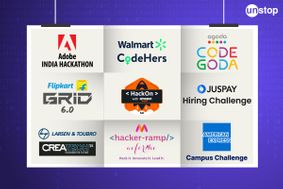
Organize Hackathons: The Ultimate Playbook With Past Case Studies

What is Campus Recruitment? How To Tap The Untapped Talent?

Lateral Hiring: A Complete Guide To The Process, Its Benefits, Challenges & Best Practices
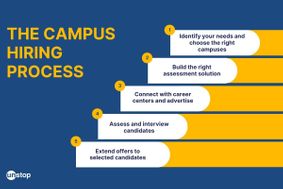








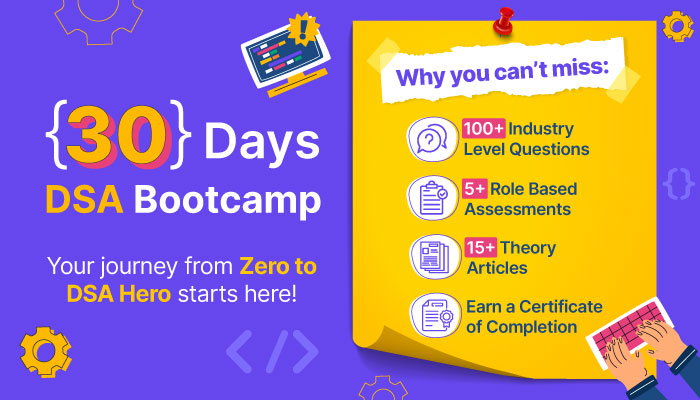



Comments
Add comment